Text

The fossa, a fascinating creature native to Madagascar, has a distinct appearance that suits its role as one of the island's top predators. These animals are sleek and have a long, slender body covered in short, reddish-brown fur. Their tails are quite long, sometimes even longer than their bodies. What makes fossas truly scary predators are their sharp claws, keen senses, and powerful jaws with sharp teeth. They are excellent climbers and can swiftly move through trees to chase down their prey, often lemurs and other small animals. Fossas make eerie, high-pitched sounds in the forests of Madagascar, adding to their intimidating reputation. As apex predators, fossas play a vital role in keeping the ecosystem in check on this unique island, showcasing the incredible biodiversity found there.
0 notes
Text

The Komodo dragon (Varanus komodoensis) is a legendary and formidable reptile that commands respect in the animal kingdom. These immense, carnivorous lizards are the largest living species of lizard on Earth, with some individuals reaching lengths of up to 10 feet and weighing over 300 pounds. Found exclusively on a few Indonesian islands, including Komodo, Rinca, Flores, and Gili Motang, they are apex predators, using their keen sense of smell and ambush tactics to hunt prey, which can range from small mammals to large deer. Armed with serrated teeth and a powerful bite that delivers a potent mix of bacteria and venom, a Komodo dragon's bite can prove deadly to its victims over time. Despite their fearsome reputation, these creatures are also essential to their ecosystems, helping to control populations of herbivores. Their unique biology, large size, and mysterious allure have made them a subject of fascination for scientists and wildlife enthusiasts around the world.
0 notes
Text

The platypus is a truly remarkable mammal with a unique DNA structure that reflects its extraordinary evolutionary history. These semi-aquatic creatures, native to Australia, are famous for their peculiar combination of features, including a duckbill, webbed feet, and the ability to lay eggs. What makes the platypus even more intriguing is its DNA, which contains a mosaic of genetic elements from both mammals and reptiles. Their sex chromosomes, for instance, resemble those found in birds and reptiles rather than the typical mammalian XX and XY. This genetic quirk has fascinated scientists for years, offering insights into the evolutionary history of mammals. The platypus's DNA is like a biological time capsule, reminding us of the incredible diversity of life on our planet and the complex interplay of genes that have shaped it over millions of years.
0 notes
Text

This is Bakai seal, a truly unique and enchanting creature. What immediately sets the Bakai seal apart is its endearing, disproportionately large eyes, which seem to peer into the secrets of the freshwater world it inhabits. Measuring as the smallest seal in the world, the Bakai seal stands as a testament to nature's remarkable diversity. Unlike its saltwater counterparts, this seal is exclusively adapted to thrive in freshwater habitats, carving out its niche in rivers and lakes. The Bakai seal's intriguing combination of features and habitat preference make it a captivating and distinctive member of the aquatic animal kingdom.
1 note
·
View note
Text

More and more elephants are being born without tusks due to a phenomenon known as "evolutionary selection pressure." This change in elephant populations is a direct result of the relentless and illegal poaching of elephants for their ivory tusks. Over many generations, elephants with larger tusks were prime targets for poachers, as their ivory had significant market value. Consequently, these elephants were more likely to be killed before they could reproduce, while those with smaller or no tusks had a better chance of survival and passing on their genes. This selective pressure has led to a higher prevalence of tuskless elephants in some populations, as they are less likely to be targeted by poachers. While this adaptation may offer short-term advantages, it underscores the devastating impact of human activities on these magnificent creatures and the urgent need for conservation efforts to protect and preserve their populations.
1 note
·
View note
Text

Pigmy Seahorses are fascinating creatures that exhibit remarkable characteristics. One intriguing fact about seahorses in general is their tendency to mate for life, forming enduring bonds with their chosen partners. These tiny pygmy seahorses, despite their diminutive size of up to 2.7 cm, possess a remarkable talent for camouflage. They have evolved to blend seamlessly with their surroundings, often matching the exact coloration of the sea fan coral they call home. This remarkable adaptation allows them to virtually disappear from the view of most potential predators, offering them a clever and effective means of survival in the vibrant underwater ecosystems they inhabit. The pygmy seahorse's ability to form lifelong partnerships and its mastery of camouflage make it a truly captivating and resilient species within the ocean's diverse tapestry of life.
0 notes
Text

The saiga antelope, scientifically known as Saiga tatarica, is a unique and endangered species native to the vast steppes and semi-arid regions of Central Asia, particularly in Russia and Kazakhstan. Known for its distinctive appearance, the saiga possesses a distinctive bulbous nose, which helps filter and cool the air in the extreme temperatures of its habitat. These herbivorous creatures primarily graze on a variety of steppe grasses and play a crucial role in maintaining the ecosystem's balance. Unfortunately, saiga antelopes have faced significant population declines in recent years due to habitat loss and poaching for their horns, which are highly valued in traditional medicine. Conservation efforts are underway to protect and preserve these remarkable animals and their unique habitat.
0 notes
Text
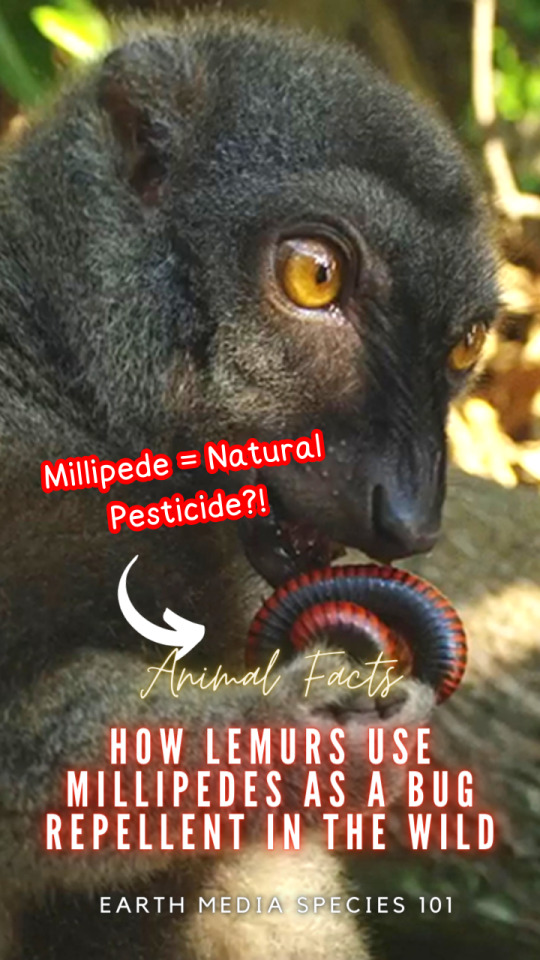
Lemurs in Madagascar have an interesting relationship with millipedes. These curious creatures sometimes interact with millipedes in a peculiar way. When they come across a millipede, they might sniff, lick, or even nibble on it. This behavior might seem strange, but it's believed to serve a purpose. Millipedes release toxins as a defense mechanism, and lemurs, by rubbing or licking the millipedes, can spread these toxins onto their fur. It's thought that lemurs use these millipede toxins as a form of insect repellent. The chemicals from the millipedes can deter bothersome insects, such as mosquitoes, and help keep the lemurs comfortable in the lush forests of Madagascar. So, while lemurs and millipedes might have an unusual connection, it's another example of how nature's creatures find unique ways to adapt and thrive in their environments.
0 notes
Text

The Gharial crocodile, scientifically known as Gavialis gangeticus, is a truly unique and remarkable reptile. It's instantly recognizable by its long, slender snout lined with approximately 110 sharp teeth. This specialized snout sets it apart from other crocodilians and is adapted for its primary diet of fish. Adult males of the species can reach impressive lengths of up to 23 feet, making them among the largest freshwater predators in India. Gharials are primarily found in the rivers of India, where they play a vital role in maintaining the aquatic ecosystem by controlling fish populations. Despite their fearsome appearance, Gharials are generally not a threat to humans due to their limited snout opening, but it's still wise to exercise caution around these intriguing reptiles. Unfortunately, this unique species faces conservation challenges, and efforts are being made to protect and preserve their dwindling populations in the wild.
0 notes
Text

Archerfish, scientifically known as Toxotes, are truly remarkable aquatic creatures found in the tropical waters of Southeast Asia and Northern Australia. These sleek and agile fish have earned their name due to their extraordinary hunting technique. Archerfish possess a unique ability to shoot down insects and other prey from overhanging branches by spitting a precise jet of water. They use their specialized mouth and gill structures to create a powerful stream, which can accurately target prey up to several feet away. This incredible skill not only aids in their survival but also showcases the remarkable adaptability of nature's engineering. Archerfish are a testament to the ingenious ways in which organisms have evolved to thrive in their diverse environments.
0 notes
Text

The colugo, often referred to as the "flying lemur," is a remarkable creature found in Southeast Asia. Despite its name, it's not a lemur at all, and it doesn't truly fly either. Instead, the colugo possesses a unique ability called "gliding," using a specialized membrane of skin called the patagium that stretches between its limbs and tail. This allows it to gracefully glide through the treetops in search of its favorite snacks: leaves, shoots, and fruits. With large, round eyes adapted for night vision, the colugo is a stealthy nocturnal glider. It's fascinating how they can glide up to 200 feet between trees, showcasing their superb aerial agility. Interestingly, when you catch a glimpse of a colugo mid-glide, you might just think you're looking at a flying squirrel on steroids! Their resemblance to flying squirrels takes acrobatics to a whole new level—with a touch of comedy.
0 notes
Text
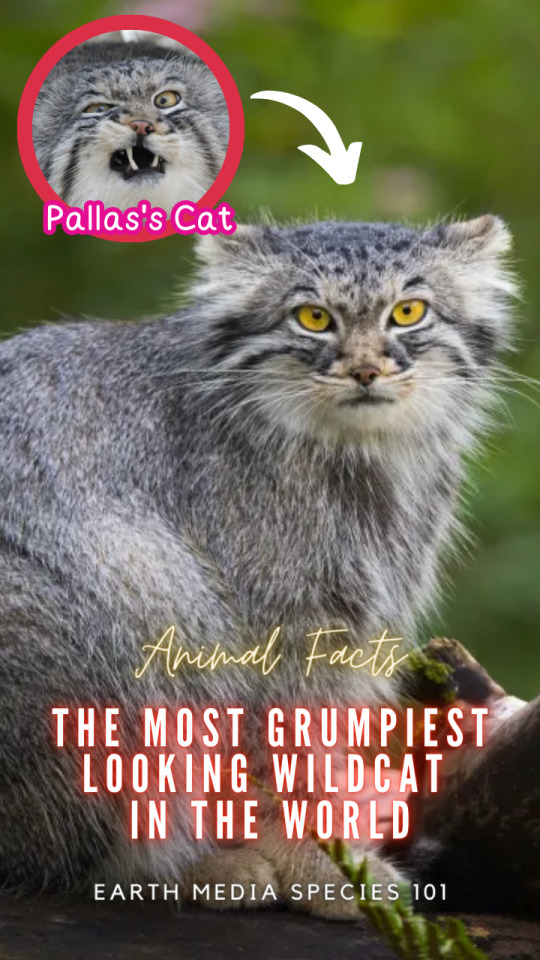
Pallas’s Cat — the Most Grumpiest Wildcat in the World
The Pallas’s cat, a mesmerizing feline native to the high-altitude landscapes of Central Asia, stands out with its utterly distinctive appearance and fur. Renowned for its expressive face, marked by rounded pupils and a flat visage, the Pallas’s cat possesses a charm that lies in its unconventional beauty. Its dense, plush fur, adapting to the harsh climates of its habitat, grants it a peculiar, stout appearance, almost akin to a living teddy bear. This evolution in fur texture and pattern can be attributed to the cat’s challenging environment, where extreme cold and rocky terrains prevail. The luxurious fur provides exceptional insulation against the biting cold, while the cryptic, irregular markings serve as camouflage, enabling the cat to blend seamlessly into its rocky surroundings and avoid detection by potential predators and prey alike. The unique attributes of the Pallas’s cat are a testament to the wonders of adaptation, allowing this enigmatic feline to thrive in some of the planet’s most unforgiving landscapes.
0 notes
Text
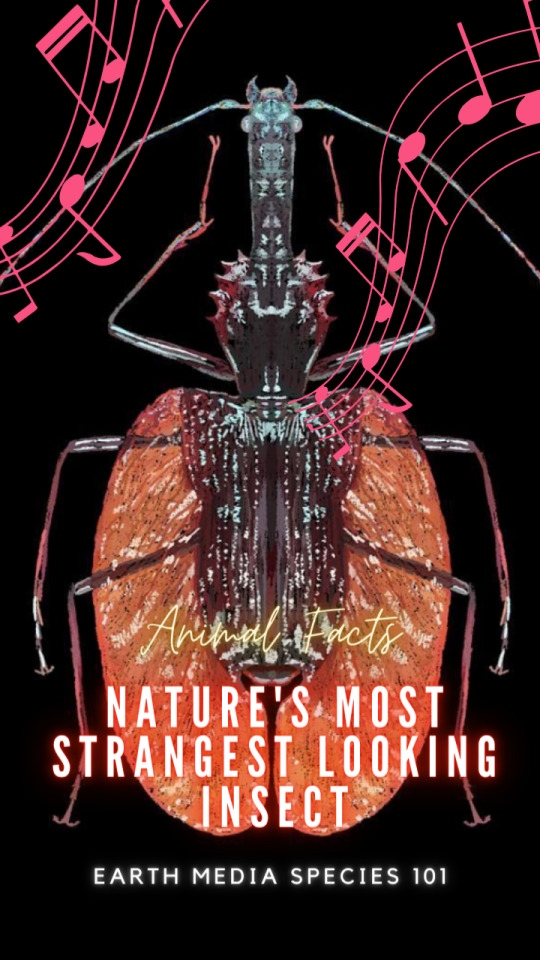
The violin beetle, scientifically known as Mormolyce phyllodes, is a remarkable insect belonging to the family Cerambycidae. It derives its common name from its distinctive body shape, which resembles that of a violin, with an elongated thorax and abdomen that widen near the middle, mimicking the curves of the musical instrument. These beetles are primarily found in tropical rainforests of Southeast Asia, where their unique appearance serves as camouflage among fallen leaves and debris on the forest floor. The violin beetle's striking appearance is also thought to play a role in deterring potential predators, as its shape and coloration might be mistaken for a larger, less palatable creature. Despite its unusual form, the violin beetle is a testament to nature's creativity in adapting to various ecological niches.
0 notes
Text

The clouded leopard, a mesmerizing inhabitant of the Asian wilderness, captivates with its ethereal beauty and remarkable adaptations. Distinguished by its cloud-like markings, it gracefully maneuvers through the dense canopies of evergreen tropical forests, adapting to both arboreal and terrestrial environments. With its arboreal prowess, it possesses a tail almost half its body length, enabling unparalleled balance during daring leaps and chases. Its large, expressive eyes and intricate coat mirror its enigmatic nature, while its distinctive vocalizations resonate through its diverse habitats, emphasizing its presence. Despite its captivating charm, the clouded leopard faces the harsh reality of poaching and habitat loss, underscoring the urgency of conservation efforts to safeguard this exquisite species for generations to come.
0 notes
Text

Gorillas are incredibly strong creatures, surpassing the physical strength of humans by a significant margin. An adult male gorilla, in particular, can exhibit remarkable strength, with estimates suggesting they can be up to six times stronger than an average human. This immense strength is a product of their robust build, powerful muscles, and adaptations developed over millions of years to thrive in their natural environment. While human beings excel in various cognitive and technological aspects, our physical strength is comparatively modest when juxtaposed with the sheer power of these awe-inspiring primates.
1 note
·
View note
Text
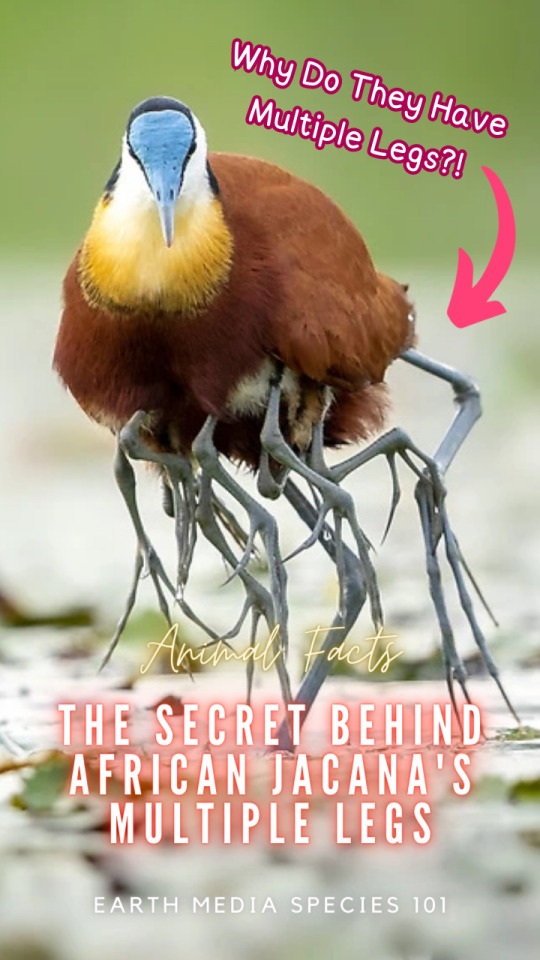
The African Jacana, a captivating inhabitant of the wetlands across sub-Saharan Africa, presents a unique role reversal in the realm of parenting. In a departure from conventional norms, it is the males of this species that take on the primary responsibilities of nurturing their offspring. Once the female has laid her eggs, she entrusts the crucial task of incubation to the male, who diligently safeguards the eggs from potential threats and the elements. What's even more remarkable is the sight that unfolds when the chicks hatch. Seeking protection and warmth, the chicks instinctively seek refuge under their father's outstretched wings. This ingenious behavior not only keeps the vulnerable chicks safe but also creates a mesmerizing visual illusion. With their tiny bodies nestled under the male's wings, the arrangement gives the impression of a single creature with multiple legs, an optical trick that serves as both a survival strategy and a marvel of nature's design.
0 notes
Text
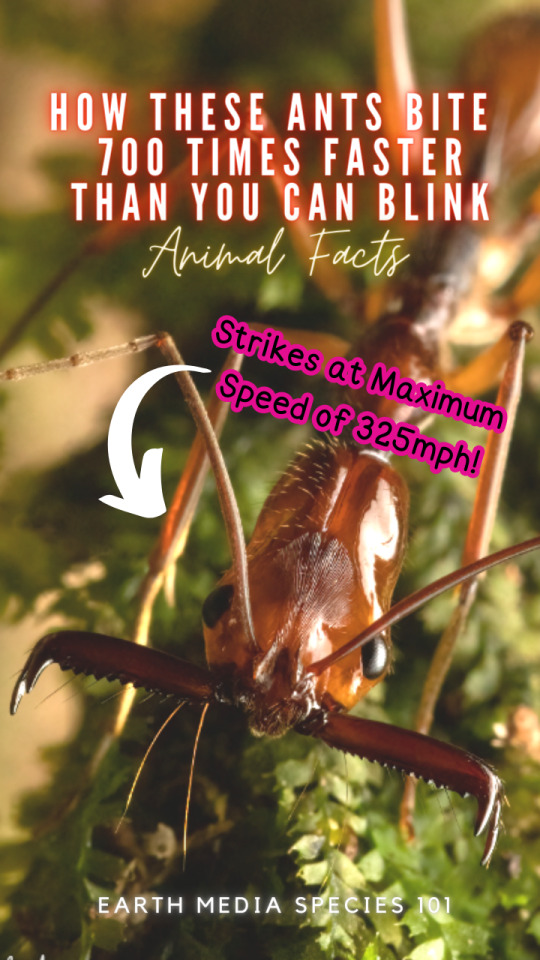
The trap-jaw ant, a remarkable insect found in various tropical regions, is renowned for its incredible predatory mechanisms and distinctive appearance. Named for its powerful mandibles that can snap shut with astonishing speed and force, these ants employ their unique jaws for both hunting and defensive purposes. When threatened or capturing prey, the ant's mandibles are capable of closing at speeds exceeding 145 miles per hour, enabling them to deliver a swift and deadly bite. This adaptation, along with their keen sense of touch and impressive coordination, makes trap-jaw ants highly efficient predators. Their nests are often well-organized and can house numerous individuals working together in a highly organized social structure. These fascinating creatures exemplify the marvels of natural adaptation and behavior within the intricate world of ants.
0 notes